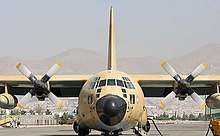1981 Iranian Air Force C-130 crash
On 29 September 1981, an Iranian Air Force C-130 military cargo aircraft crashed into a firing range near Kahrizak, Iran. The plane was flying from Ahvaz, Khuzestan Province to Tehran, while returning from an inspection tour of Iranian military gains in the Iran–Iraq War.
 An Iranian Air Force C-130E Hercules similar to the aircraft that crashed | |
| Crash | |
|---|---|
| Date | 29 September 1981 |
| Summary | Crashed into structure |
| Site | Firing range near Kahrizak, Iran |
| Aircraft | |
| Aircraft type | Lockheed C-130 Hercules |
| Registration | 505 |
| Flight origin | Ahvaz, Khuzestan Province |
| Destination | Tehran |
| Fatalities | 80 |
The crashed killed 80 people, including former Defence Minister Javad Fakoori, then-Defence Minister Mousa Namjoo, then-Chief-of-Staff of the Army Valiollah Fallahi, and then-commander of the Islamic Revolutionary Guard Corps Mohammad Jahanara.
Background
In order to break the Siege of Abadan, the Operation Samen-ol-A'emeh was performed from 27 to 29 September 1981.[1] To transfer the report of the Operation Samen-ol-A'emeh to Tehran, it was decided that several Iranian military leaders were to return to Tehran by a Lockheed C-130 Hercules aircraft.[2]
Crash
At 19:00 local time (15:30 UTC) on 29 September 1981, the C-130 cargo aircraft crashed into a firing range near Kahrizak, Iran.[3][4] The plane was flying from Ahvaz in southwestern Khuzestan Province to Tehran,[5] while returning from an inspection tour of Iranian military gains in the Iran–Iraq War.[6]
Casualties

The crashed killed all 80 people on board,[4] including former Defence Minister Javad Fakoori, then-Defence Minister Mousa Namjoo, Iranian General Valiollah Fallahi, and then-commander of the Islamic Revolutionary Guard Corps Mohammad Jahanara.[5] The four had played vital roles in the Iran–Iraq War, and the plane was carrying casualties of the war.
Initially, there was no official explanation for what caused the crash. The crash caused Iran to lose several military leaders, who were trying to break the Siege of Abadan. An undetermined number of Iranians who were wounded from the war were also in the plane.[3]
Causes
There was no official explanation given for reasons of the crash, and just one source called it the result of a "technical fault".[5]
References
- Hanizadeh, Hassan. "Khorramshahr: From occupation to liberation". Mehrnews. Archived from the original on 24 September 2018. Retrieved 23 May 2009.
- "ناگفتههایی از سقوط هواپیمای C130 حامل فرماندهان ارتش و سپاه". Fars news. Archived from the original on 22 November 2018. Retrieved 28 September 2015.
- Kifner, John (1 October 1981). "4 MILITARY CHIEFS IN IRAN ARE KILLED IN A PLANE CRASH". The New York Times. Archived from the original on 28 September 2018. Retrieved 23 September 2018.
- "C-130 Accidents & Mishaps for the Islamic Republic of Iran Air Force". C-130. Archived from the original on 2 January 2019. Retrieved 23 September 2018.
- Rizvi, Sajid (30 September 1981). "Four top Iranian generals killed in plane crash". United Press International. Archived from the original on 1 January 2019. Retrieved 23 September 2018.
- Smith, Winston. "Iran's mysterious military plane crashes that amount to "mass purges"". The Aviationist. Archived from the original on 9 January 2014. Retrieved 7 January 2014.